GLAD Scale for Ranking Welfare of Horses on Arrival after Transport to Slaughterhouses
Abstract
Simple Summary
Abstract
1. Introduction
2. Materials and Methods
2.1. Data Collection
2.2. Data Handling
2.3. Formulas
2.3.1. ABM Weight,
2.3.2. Welfare Impairment Score, S
2.3.3. GLAD Scale Construction
- Good shape: the animals are not at all or are affected very little after transport, so they can be taken directly to the slaughterhouse without any actions.
- Lightly affected: the animals have slight welfare disorders for which a restorative rest in the lairage would suffice before slaughtering.
- Affected: the animals are sufficiently affected after transport that their welfare state requires treatment actions to restore it to better conditions for the slaughterhouse.
- Down: the animals are seriously affected after transport. The horses cannot stand and walk on arrival, they are exhausted. Competent authorities must treat them immediately. The animal must be stunned immediately in the vehicle and then be transferred to the slaughterhouse mechanically to complete the procedure. The meat has to be checked carefully [34].
2.3.4. Thresholds , and
- : Based on an inventory of ABMs mostly found on animals in the down state (as defined above), can be considered as the (nonzero) minimum of welfare impairment scores of animals in that situation.
- : As is the lower band of the worst-case status, and divides the range, 0 < S < , into 2 parts: that of scores S < corresponding to states with less-alarming welfare impairments, and that of scores S ≥ representing welfare so altered that veterinary actions are required. Therefore, can be set as the (nonzero) minimum of welfare impairment scores for target ABMs.
- : Finally, can be defined as a proportion of S2 below which the impairment status of welfare can be considered acceptable for slaughter.
- : the ABM “Down” was used as representative of the down state. Indeed, animals with downing troubles are in such bad shape that they tick all the boxes of welfare concerns, affecting all 4 welfare principles. The welfare impairment score corresponding to a downer (i.e., a horse with the ABM down) is: . Furthermore, animals below (with no apparent down state) but close (with several other ABMs) to this threshold can be included in the down state for veterinary officer (VO) intervention. To this end, we used:
- : The ABM “Injuries” was assumed to represent highly impaired welfare requiring immediate actions or interventions. Then, S2 was chosen at 90% of the highest score associated with injuries as:
- : It was assumed that significant impairments start from approximately 20% of , i.e.:
3. Results
3.1. Horse Welfare Impairment Degree (WIDs)
3.2. Distribution and Prevalence of Animal-Based-Measurements (ABMs)
4. Discussion
5. Conclusions
Author Contributions
Funding
Institutional Review Board Statement
Informed Consent Statement
Data Availability Statement
Acknowledgments
Conflicts of Interest
References
- Alonso, M.E.; González-Montaña, J.R.; Lomillos, J.M. Consumers’ concerns and perceptions of farm animal welfare. Animals 2020, 10, 385. [Google Scholar] [CrossRef]
- Berthe, F.; Vannier, P.; Have, P.; Serratosa, J.; Bastino, E.; Maurice Broom, D.; Hartung, J.; Michael Sharp, J. The role of EFSA in assessing and promoting animal health and welfare. EFSA J. 2012, 10, s1002. [Google Scholar] [CrossRef]
- European Food Safety Authority (EFSA) Panel on Animal Health and Welfare (AHAW); Nielsen, S.S.; Alvarez, J.; Bicout, D.J.; Calistri, P.; Canali, E.; Drewe, J.A.; Garin-Bastuji, B.; Gonzales Rojas, J.L.; Gortázar Schmidt, C.; et al. Welfare of equidae during transport. EFSA J. 2022, 20, e07444. [Google Scholar] [CrossRef] [PubMed]
- Mellor, D.J.; Reid, C.S.W. Concepts of animal well-being and predicting the impact of procedures on experimental animals. In Improving the Well-Being of Animals in the Research Environment; Baker, R.M., Jenkin, G., Mellor, D.J., Eds.; Australian and New Zealand Council for the Care of Animals in Research and Teaching: Glen Osmond, Australia, 1994; pp. 3–18. [Google Scholar]
- Blokhuis, H.J.; Veissier, I.; Miele, M.; Jones, B. The Welfare Quality® project and beyond: Safeguarding farm animal well-being. Acta Agric. Scand.—A Anim. Sci 2010, 60, 129–140. [Google Scholar] [CrossRef]
- Animal Welfare Indicator (AWIN). AWIN Welfare Assessment Protocol for Horses. 2015. Available online: https://air.unimi.it/handle/2434/269097 (accessed on 28 March 2023).
- Main, D.C.J.; Kent, J.P.; Wemelsfelder, F.; Ofner, E.; Tuyttens, F.A.M. Applications for methods of on-farm welfare assessment. Anim. Welf. 2003, 12, 523–528. [Google Scholar] [CrossRef]
- Welfare Quality®. Welfare Quality® Assessment Protocol for Poultry (Broilers, Laying Hens); Welfare Quality Consortium: Lelystad, The Netherlands, 2009. [Google Scholar]
- Welfare Quality®. Welfare Quality® Assessment Protocol for Pigs (Sows and Piglets, Growing and Finishing Pigs); Welfare Quality Consortium: Lelystad, The Netherlands, 2009. [Google Scholar]
- Welfare Quality®. Welfare Quality® Assessment Protocol for Cattle; Welfare Quality Consortium: Lelystad, The Netherlands, 2009. [Google Scholar]
- Animal Welfare Indicator (AWIN). AWIN Welfare Assessment Protocol for Donkeys. 2015. Available online: https://air.unimi.it/handle/2434/269100 (accessed on 28 March 2023).
- Animal Welfare Indicator (AWIN). AWIN Welfare Assessment Protocol for Goats. 2015. Available online: https://air.unimi.it/handle/2434/269102 (accessed on 28 March 2023).
- Animal Welfare Indicator (AWIN). AWIN Welfare Assessment Protocol for Turkeys. 2015. Available online: https://air.unimi.it/handle/2434/269107 (accessed on 28 March 2023).
- Animal Welfare Indicator (AWIN). AWIN Welfare Assessment Protocol for Sheep. 2015. Available online: https://air.unimi.it/handle/2434/269114 (accessed on 28 March 2023).
- Mellor, D.J. Taming and training of pregnant sheep and goats and of newborn lambs, kids and calves before experiment. Altern. Lab. Anim. 2004, 32 (Suppl. S1), 143–146. [Google Scholar] [CrossRef]
- Littlewood, K.E.; Mellor, D.J. Changes in the welfare of an injured working farm dog assessed using the Five Domains Model. Animals 2016, 6, 58. [Google Scholar] [CrossRef] [PubMed]
- McGreevy, P.; Berger, J.; de Brauwere, N.; Doherty, O.; Harrison, A.; Fiedler, J.; Jones, C.; McDonnell, S.; McLean, A.; Nakonechny, L.; et al. Using the Five Domains Model to assess the adverse impacts of husbandry, veterinary, and equitation interventions on horse welfare. Animals 2018, 8, 41. [Google Scholar] [CrossRef]
- Botreau, R.; Veissier, I.; Butterworth, A.; Bracke, M.B.M.; Keeling, L.J. Definition of criteria for overall assessment of animal welfare. Anim. Welf. 2007, 16, 225–228. [Google Scholar] [CrossRef]
- Rushen, J.; Butterworth, A.; Swanson, J.C. Animal behavior and well-being symposium. Farm animal welfare assurance: Science and application. J. Anim. Sci. 2011, 89, 1219–1222. [Google Scholar] [CrossRef]
- Dalla Costa, E.; Dai, F.; Lebelt, D.; Scholz, P.; Barbieri, S.; Canali, E.; Zanella, A.J.; Minero, M. Welfare assessment of horses: The AWIN approach. Anim. Welf. 2016, 25, 481–488. [Google Scholar] [CrossRef]
- Webster, J. Assessment of animal welfare: The Five Freedoms. In Animal Welfare: A Cool Eye Towards Eden; Blackwell Science: Oxford, UK, 1994; pp. 10–14. [Google Scholar]
- Mellor, D.J.; Beausoleil, N.J.; Littlewood, K.E.; McLean, A.N.; McGreevy, P.D.; Jones, B.; Wilkins, C. The 2020 five domains model: Including human–animal interactions in assessments of animal welfare. Animals 2020, 10, 1870. [Google Scholar] [CrossRef]
- Mellor, D.J.; Beausoleil, N.J. Extending the ‘Five Domains’ model for animal welfare assessment to incorporate positive welfare states. Anim. Welf. 2015, 24, 241–253. [Google Scholar] [CrossRef]
- European Food Safety Authority (EFSA) Panel on Animal Health and Welfare (AHAW); Bøtner, A.; Broom, D.; Doherr, M.G.; Domingo, M.; Hartung, J.; Keeling, L.; Koenen, F.; More, S.; Morton, D.; et al. Statement on the use of animal-based measures to assess the welfare of animals. EFSA J. 2012, 10, 2767. [Google Scholar] [CrossRef]
- Lesimple, C. Indicators of horse welfare: State-of-the-art. Animals 2020, 10, 294. [Google Scholar] [CrossRef]
- Padalino, B. Effects of the different transport phases on equine health status, behavior, and welfare: A review. J. Vet. Behav. 2015, 10, 272–282. [Google Scholar] [CrossRef]
- Messori, S.; Visser, E.; Buonanno, M.; Ferrari, P.; Barnard, S.; Borciani, M.; Ferri, N. A tool for the evaluation of slaughter horse welfare during unloading. Anim. Welf. 2016, 25, 101–113. [Google Scholar] [CrossRef]
- Felici, M.; Nanni Costa, L.; Zappaterra, M.; Bozzo, G.; Di Pinto, P.; Minero, M.; Padalino, B. Journeys, journey conditions, and welfare assessment of broken (handled) horses on arrival at Italian slaughterhouses. Animals 2022, 12, 3122. [Google Scholar] [CrossRef] [PubMed]
- Zappaterra, M.; Nanni Costa, L.; Felici, M.; Minero, M.; Perniola, F.; Tullio, D.; Padalino, B. Journeys, journey conditions, and welfare assessment of unbroken (unhandled) horses on arrival at a slaughterhouse in Italy. Animals 2022, 12, 2083. [Google Scholar] [CrossRef]
- Miranda-de la Lama, G.C.; Gonzales-Castro, C.A.; Gutierrez-Piña, F.J.; Villarroel, M.; Maria, G.A.; Estévez-Moreno, L.X. Welfare of horses from Mexico and the United States of America transported for slaughter in Mexico: Fitness profiles for transport and pre-slaughter logistics. Prev. Vet. Med. 2020, 180, 105033. [Google Scholar] [CrossRef]
- Carroll, C.L.; Huntington, P.J. Body condition scoring and weight estimation of horses. Equine Vet. J. 1988, 20, 41–45. [Google Scholar] [CrossRef]
- Whiting, J. The exhausted horse. In Current Therapy in Equine Medicine, 6th ed.; Robinson, N.E., Sprayberry, K.A., Eds.; Saunders Elsevier: Philadelphia, PA, USA, 2009; pp. 926–929. [Google Scholar]
- Waiblinger, S.; Menke, C.; Coleman, G. The relationship between attitudes, personal characteristics and behaviour of stockpeople and subsequent behaviour and production of dairy cows. Appl. Anim. Behav. Sci. 2002, 79, 195–219. [Google Scholar] [CrossRef]
- Council Regulation (EC) No. 1099/2009 of 24 September 2009 on the Protection of Animals at the Time of Killing. Council of the European Union. 2009. Available online: https://eur-lex.europa.eu/legal-content/EN/ALL/?uri=CELEX%3A32009R1099 (accessed on 28 March 2023).
- Sommerville, R.; Brown, A.F.; Upjohn, M. A standardised equine-based welfare assessment tool used for six years in low and middle income countries. PLoS ONE 2018, 13, e0192354. [Google Scholar] [CrossRef] [PubMed]
- Marlin, D.; Kettlewell, P.; Parkin, T.; Kennedy, M.; Broom, D.; Wood, J. Welfare and health of horses transported for slaughter within the European Union Part 1: Methodology and descriptive data. Equine Vet. J. 2011, 43, 78–87. [Google Scholar] [CrossRef]
- Roy, R.C.; Cockram, M.S.; Dohoo, I.R.; Ragnarsson, S. Transport of horses for slaughter in Iceland. Anim. Welf. 2015, 24, 485–495. [Google Scholar] [CrossRef]
- Federation of Veterinarians of Europe: FVE. Available online: http://www.fve.org/news/index.php?id=208#208 (accessed on 28 March 2023).
- Messori, S.; Ouweltjes, W.; Visser, K.; Dalla Villa, P.; Spoolder, H.A.M.; Baltussen, W.H.M. Improving horse welfare at transport: Definition of good practices through a Delphi procedure. In Proceedings of the 67th Annual Meeting of the European Federation of Animal Science, Belfast, UK, 29 August 2016. [Google Scholar]
- Dai, F.; Dalla Costa, A.; Bonfanti, L.; Caucci, C.; Di Martino, G.; Lucarelli, R.; Padalino, B.; Minero, M. Positive reinforcement-based training for self-loading of meat horses reduces loading time and stress-related behavior. Front. Vet. Sci. 2019, 6, 350. [Google Scholar] [CrossRef] [PubMed]
- Dai, F.; Zappaterra, M.; Minero, M.; Bocchini, F.; Riley, C.B.; Padalino, B. Equine transport-related problem behaviors and injuries: A survey of Italian horse industry members. Animals 2021, 11, 223. [Google Scholar] [CrossRef] [PubMed]
- Roy, R.C.; Cockram, M.S.; Dohoo, I.R. Welfare of horses transported to slaughter in Canada: Assessment of welfare and journey risk factors affecting welfare. Can. J. Anim. Sci. 2015, 95, 509–522. [Google Scholar]
- Stull, C.L.; Payne, M.A.; Berry, S.L.; Reynolds, J.P. A review of the causes, prevention, and welfare of nonambulatory cattle. J. Am. Vet. Med. Assoc. 2007, 231, 227–234. [Google Scholar] [CrossRef]
- McCutcheon, L.J.; Geor, R.J. Thermoregulation and exercise-associated heat illnesses. In Equine Sports Medicine and Surgery, 2nd ed.; Hinchcliff, K.W., Kaneps, A.J., Geor, R.J., Eds.; Saunders Elsevier: Philadelphia, PA, USA, 2014; pp. 901–918. [Google Scholar]
- Council Regulation (EC) No. 1/2005 of 22 December 2004 on the Protection of Animals during Transport and Related Operations and Amending Directives 64/432/EEC and 93/119/EC and Regulation (EC) No 1255/97. The Council of the European Union: Brussels, Belgium, 2004; Volume 003. Available online: https://eur-lex.europa.eu/legal-content/IT/LSU/?uri=CELEX:32005R0001 (accessed on 28 March 2023).
- Broom, D.M. The effects of land transport on animal welfare. OIE Rev. Sci. Tech. 2005, 24, 683–691. [Google Scholar] [CrossRef]
- Eurogroup for Animals. Removing the Blinkers: The Health and Welfare of European Equidae in 2015. Available online: https://www.eurogroupforanimals.org/library/removing-blinkers-health-and-welfare-european-equidae-2015 (accessed on 28 March 2023).
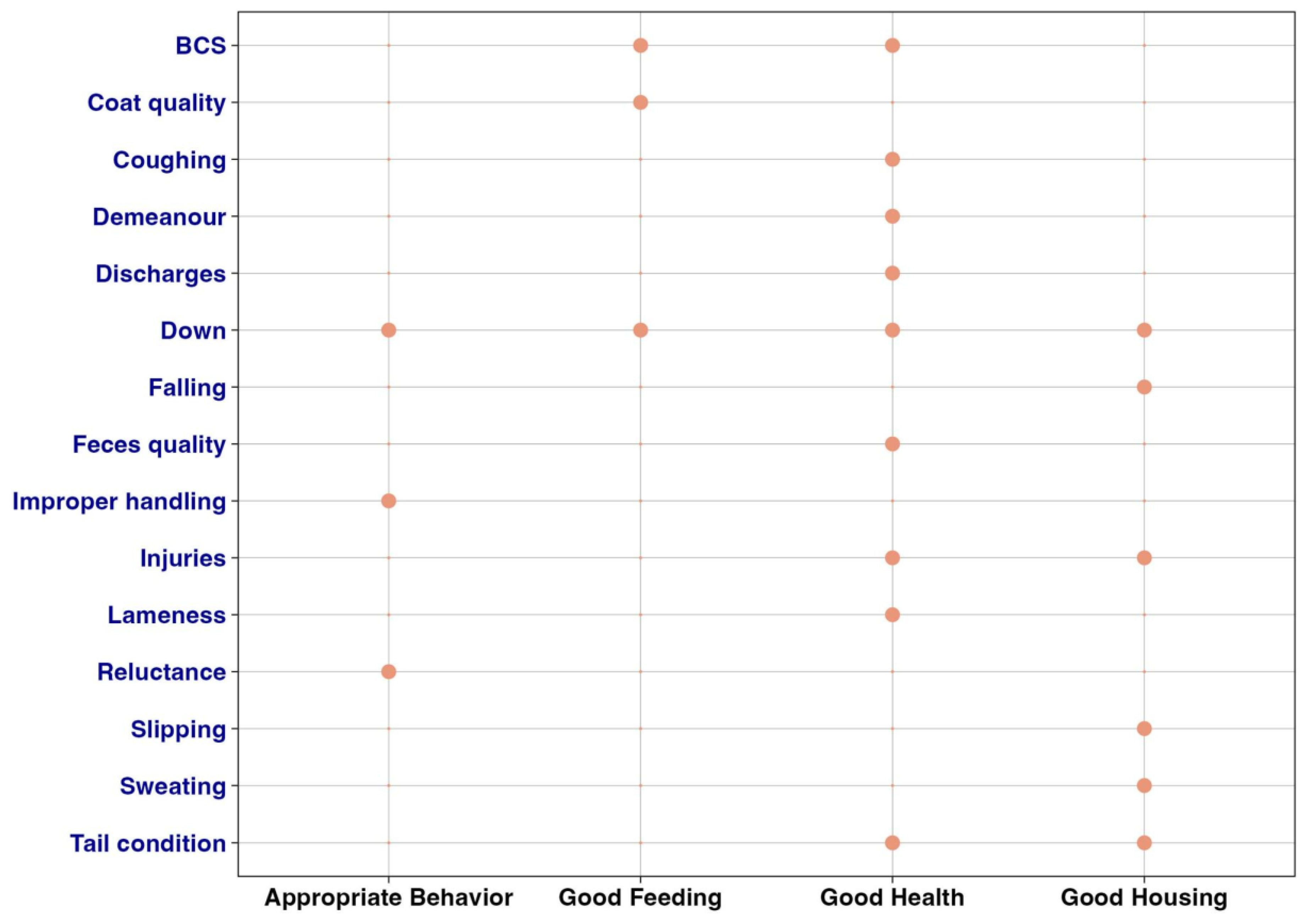
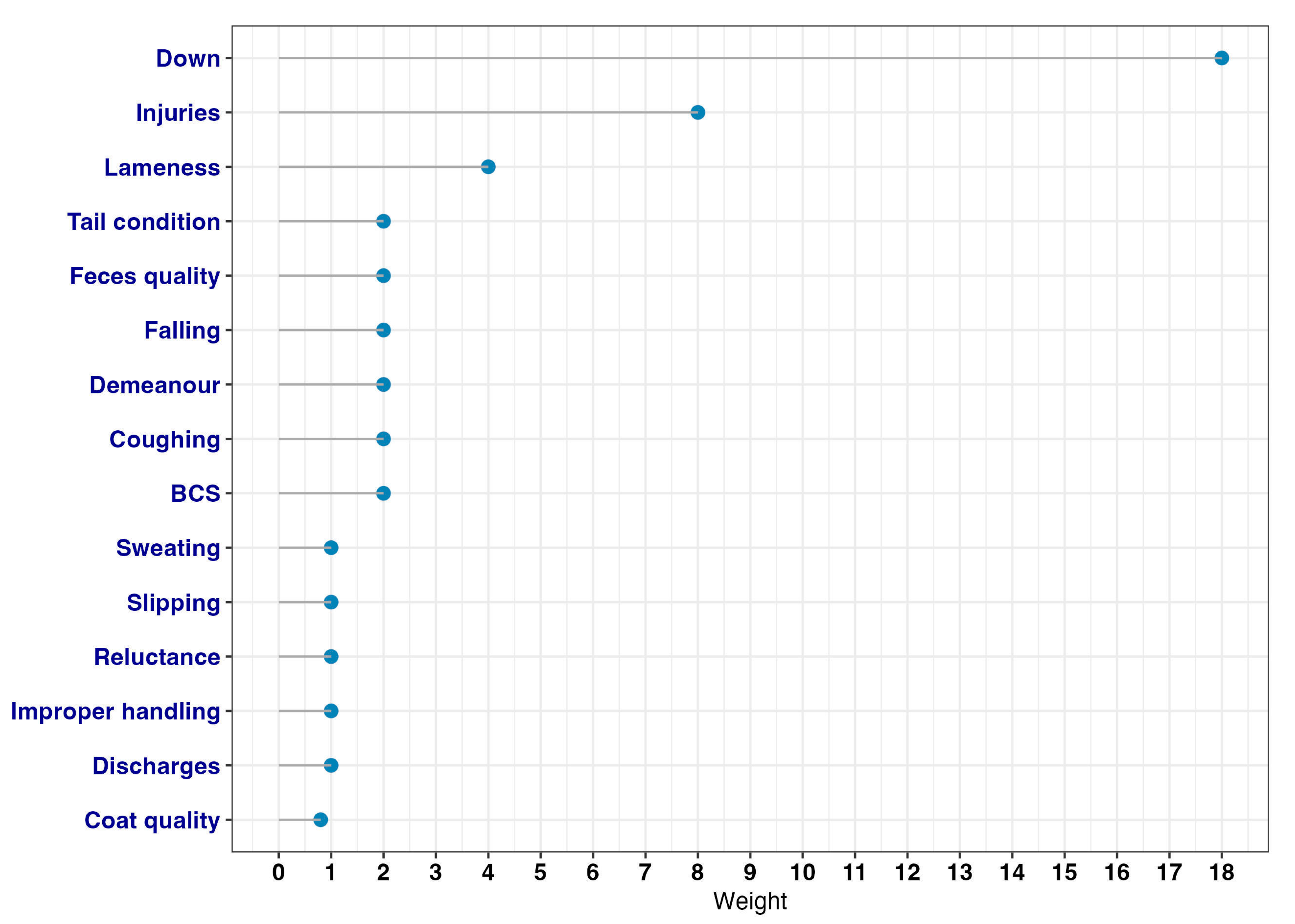
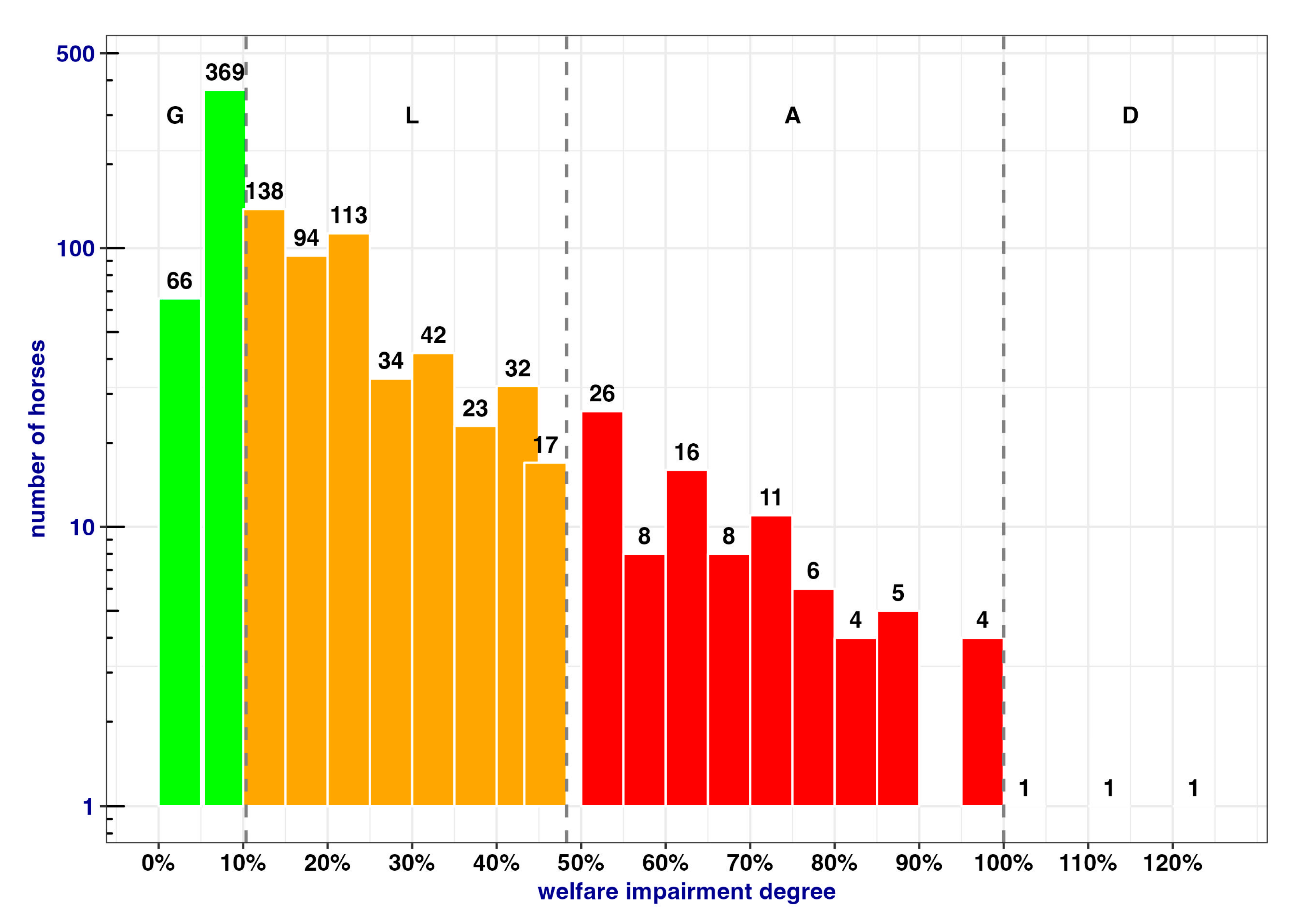
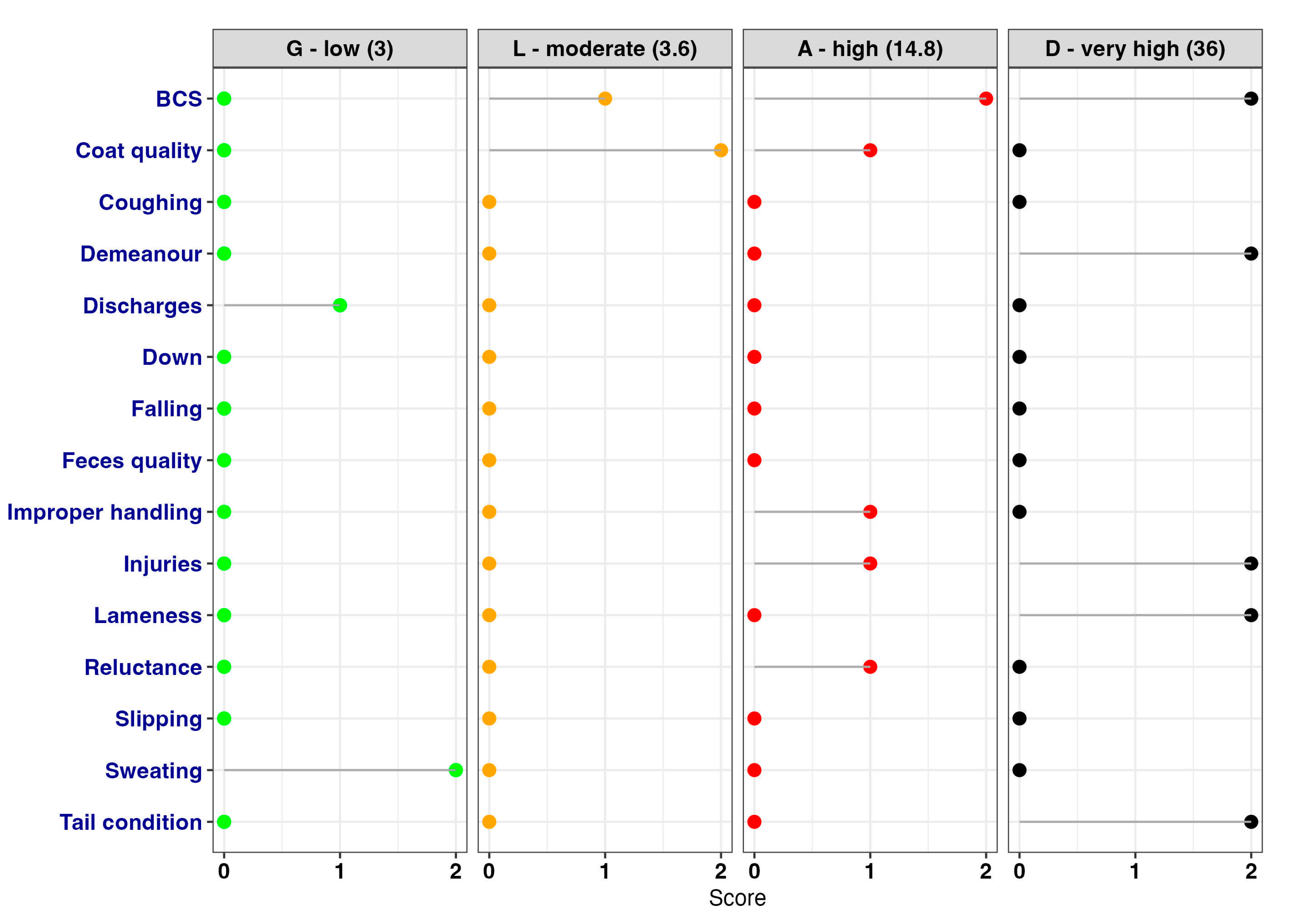
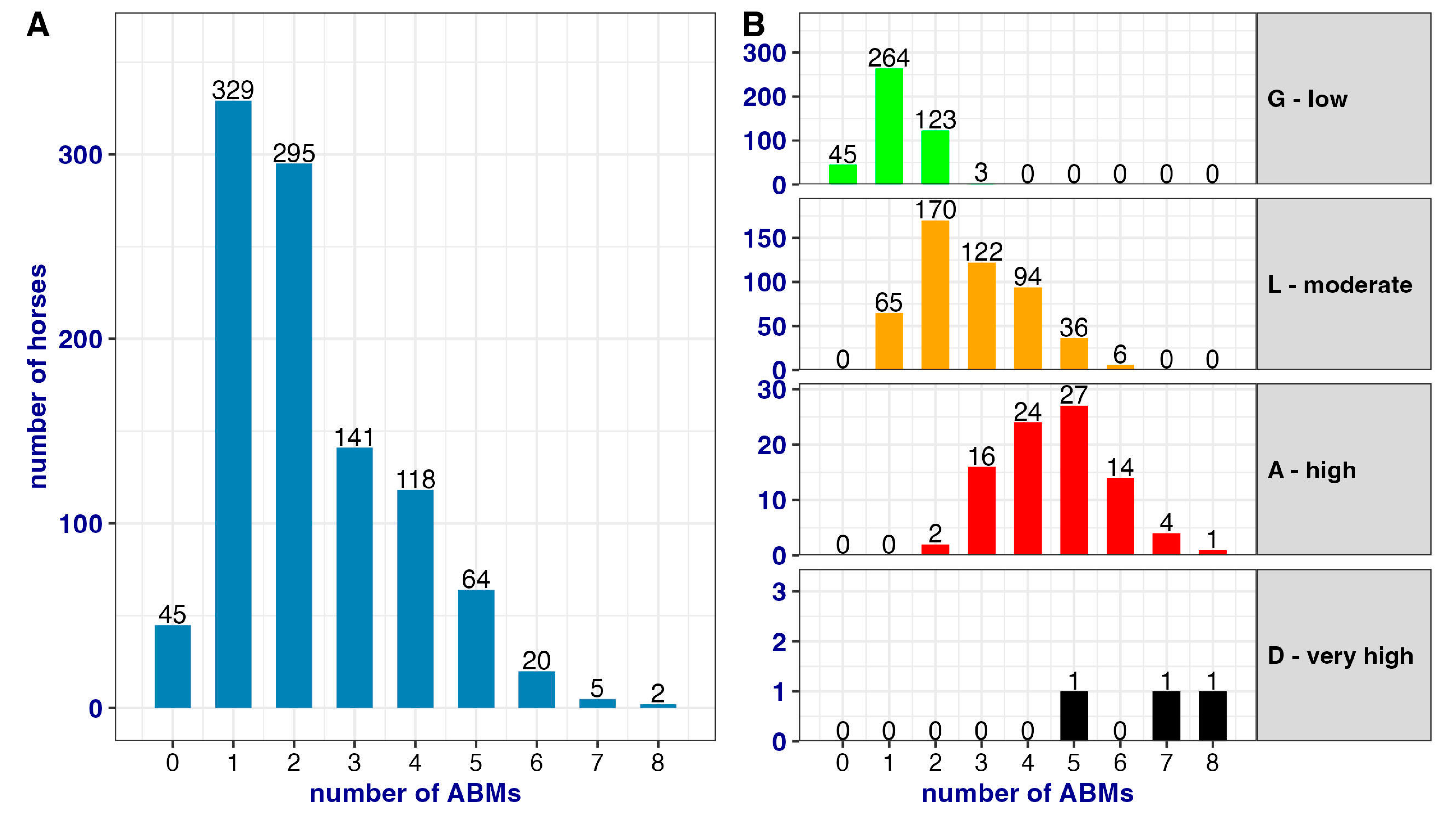
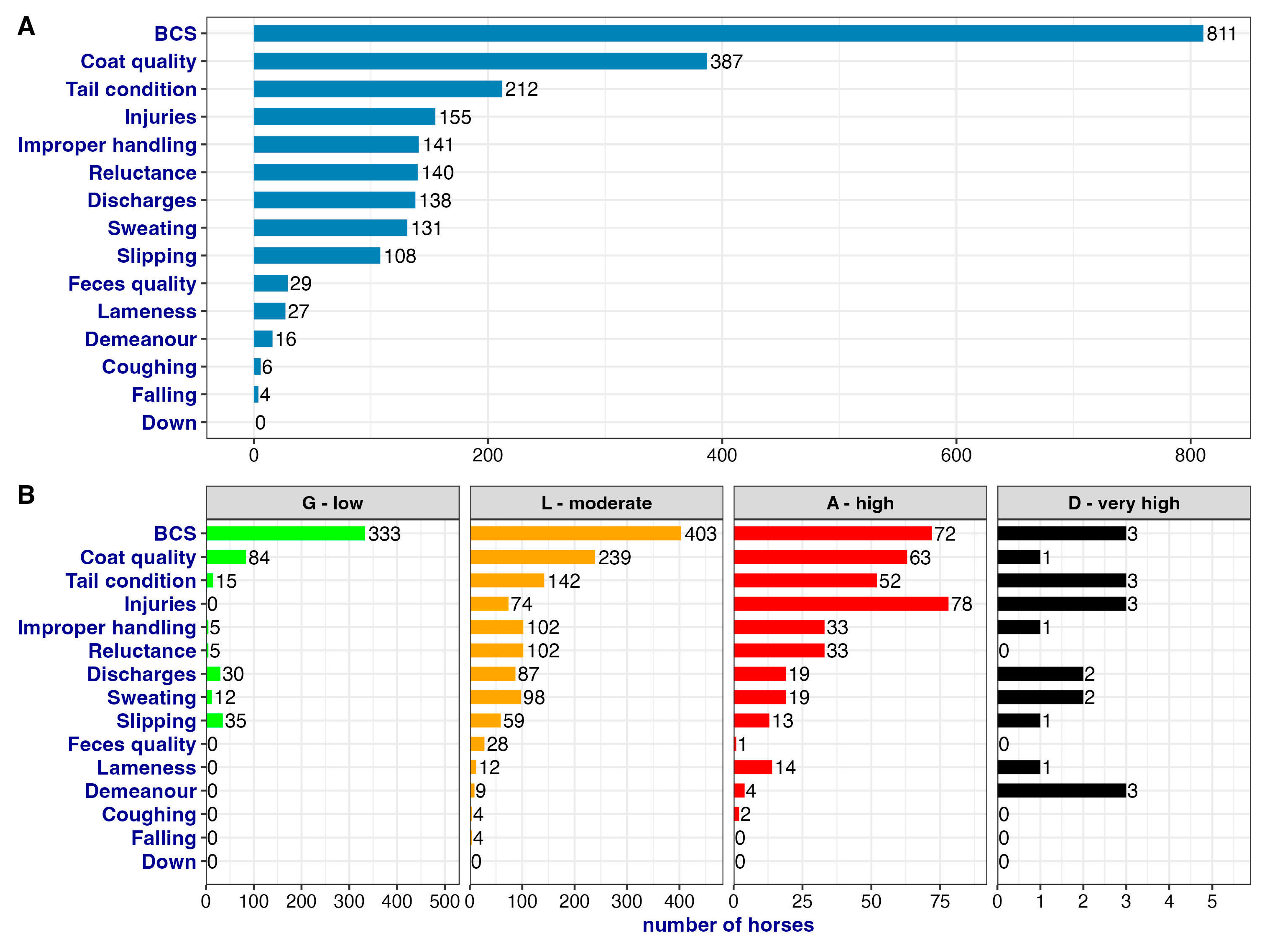
| ABM | Description | Score Explanation |
|---|---|---|
| Body condition score (BCS) | The amount of stored fat in horse’s body. Scored from 0 (very poor) to 5 (obese) [31]. | 0 = BCS of 3 1 = BCS of 2 or 4 2 = BCS of 0, 1, or 5 |
| Coat quality | Coat conditions (i.e., opaque, dry, dirty, clean, shiny) [6]. | 0 = clean/shiny coat 1 = slightly dirty/dry coat 2 = dirty/opaque coat |
| Coughing | A sudden and noisy expulsion of air from the lungs [27]. | 0 = absence of coughing 1 = presence of coughing |
| Demeanour | State of the sensorium and reactivity to external stimuli (i.e., alert/responsive, alert/quiet, lethargic, depressed, exhausted, scared) [29]. | 0 = positive demeanor (alert, responsive or alert, quiet) 1 = negative demeanor (lethargic, depressed, exhausted, scared) |
| Discharges | Loss of material from the nose or other orifices (i.e., eyes, penis, vagina, etc.) [6]. | 0 = absence of discharges 1 = presence of unilateral nasal discharge or lacrimal discharge or genital discharge 2 = presence of bilateral nasal/lacrimal discharge or combined nasal and other discharges |
| Down | The horse cannot rise or is unable to stand or walk unaided [27], “exhausted horse syndrome” [32]. | 0 = normal ambulation 1 = no ambulation |
| Falling | A loss of balance during unloading causing any part of the body (other than hooves) to touch the ground [27]. | 0 = no falling during unloading 1 = at least 1 falling during unloading |
| Feces quality | Feces consistency (i.e., watery, diarrhea, normal, compact and dry) [6]. | 0 = normal feces 1 = abnormal feces (watery, compact and dry) or diarrhea |
| Improper handling | Hit with the hand with a moderate to high use of force (i.e., a distinct sound heard) or hit with a stick with moderate to high use of force [33]. | 0 = horse being unloaded without being hit with hand or stick 1 = horse being hit with hands 1, 2, or 3 times 2 = horse being hit more than 3 times with hands and/or being beaten with a stick |
| Injuries | Cut(s) or wound(s) more or less severe on the horse’s body [29]. | 0 = absence of cuts/injuries 1 = presence of 1 cut/injury 2 = presence of 2 or more cuts/injuries |
| Lameness | A slight or modest attempt to take the weight off one or more limbs [29]. | 0 = absence of lameness 1 = presence of lameness |
| Reluctance to move/unload | Unwillingness to go forward (not caused by physical obstructions) or suddenly stopping just before the beginning or during unloading for at least 3 s [27]. | 0 = absence of reluctance to move/unload 1 = presence of reluctance to move/unload |
| Slipping | A loss of balance during unloading, without any part of the body (other than hooves) touching the ground (i.e., falling) [27]. | 0 = no slipping during unloading 1 = at least 1 slip during unloading |
| Sweating | Wet coat, dried sweat spots, or salt deposits [27]. | 0 = no sign of sweating 1 = sweating signs on part of the body 2 = sweating signs on the entire body |
| Tail condition | Presence or absence of ruffled/injured tail [29]. | 0 = no damaged tail 1 = ruffled tail 2 = open skin lesions on the tail |
| ABM | Scores | rs.Scores | bm | km | |
|---|---|---|---|---|---|
| BCS | 0, 1, 2 | 0, 1, 2 | 1.0 | 2 | 2.0 |
| Coat quality | 0, 1, 2 | 0, 1, 2 | 0.8 | 1 | 0.8 |
| Coughing | 0, 1 | 0, 2 | 2.0 | 1 | 2.0 |
| Demeanour | 0, 1 | 0, 2 | 2.0 | 1 | 2.0 |
| Discharges | 0, 1, 2 | 0, 1, 2 | 1.0 | 1 | 1.0 |
| Down | 0, 1 | 0, 2 | 4.5 | 4 | 18.0 |
| Falling | 0, 1 | 0, 1 | 2.0 | 1 | 2.0 |
| Feces quality | 0, 1 | 0, 2 | 2.0 | 1 | 2.0 |
| Improper handling | 0, 1, 2 | 0, 1, 2 | 1.0 | 1 | 1.0 |
| Injuries | 0, 1, 2 | 0, 1, 2 | 4.0 | 2 | 8.0 |
| Lameness | 0, 1 | 0, 2 | 4.0 | 1 | 4.0 |
| Reluctance to move/unload | 0, 1 | 0, 1 | 1.0 | 1 | 1.0 |
| Slipping | 0, 1 | 0, 1 | 1.0 | 1 | 1.0 |
| Sweating | 0, 1, 2 | 0, 1, 2 | 1.0 | 1 | 1.0 |
| Tail condition | 0, 1, 2 | 0, 1, 2 | 1.0 | 2 | 2.0 |
| Welfare Impairment | Color Code | State | |
|---|---|---|---|
| low | green | Good shape | |
| moderate | orange | Lightly affected | |
| high | red | Affected | |
| very high | black | Down |
| Welfare Impairment | Color Code | State | |
|---|---|---|---|
| low | green | Good shape | |
| moderate | orange | Lightly affected | |
| high | red | Affected | |
| very high | black | Down |
| N of Horses (%) | Welfare Impairment | State | |
|---|---|---|---|
| 435 () | low | Good shape | |
| 493 () | moderate | Lightly affected | |
| 88 () | high | Affected | |
| 3 () | very high | Down |
Disclaimer/Publisher’s Note: The statements, opinions and data contained in all publications are solely those of the individual author(s) and contributor(s) and not of MDPI and/or the editor(s). MDPI and/or the editor(s) disclaim responsibility for any injury to people or property resulting from any ideas, methods, instructions or products referred to in the content. |
© 2023 by the authors. Licensee MDPI, Basel, Switzerland. This article is an open access article distributed under the terms and conditions of the Creative Commons Attribution (CC BY) license (https://creativecommons.org/licenses/by/4.0/).
Share and Cite
Padalino, B.; Benedetti, B.; Felici, M.; Bicout, D.J. GLAD Scale for Ranking Welfare of Horses on Arrival after Transport to Slaughterhouses. Animals 2023, 13, 1465. https://doi.org/10.3390/ani13091465
Padalino B, Benedetti B, Felici M, Bicout DJ. GLAD Scale for Ranking Welfare of Horses on Arrival after Transport to Slaughterhouses. Animals. 2023; 13(9):1465. https://doi.org/10.3390/ani13091465
Chicago/Turabian StylePadalino, Barbara, Beatrice Benedetti, Martina Felici, and Dominique Joseph Bicout. 2023. "GLAD Scale for Ranking Welfare of Horses on Arrival after Transport to Slaughterhouses" Animals 13, no. 9: 1465. https://doi.org/10.3390/ani13091465
APA StylePadalino, B., Benedetti, B., Felici, M., & Bicout, D. J. (2023). GLAD Scale for Ranking Welfare of Horses on Arrival after Transport to Slaughterhouses. Animals, 13(9), 1465. https://doi.org/10.3390/ani13091465







